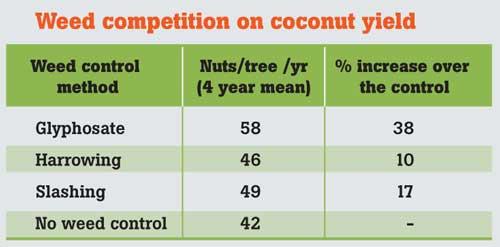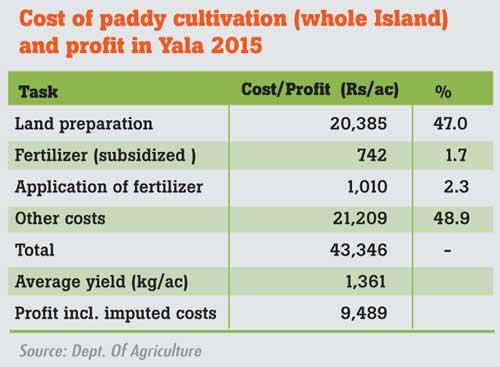14 Nov 2019 - {{hitsCtrl.values.hits}}
 Some days ago, at some gathering in Matale, President Maithripala Sirisena has raised concerns to assertions of Sajith Premadasa and Gotabaya Rajapaksa promising free fertilizers to farmers.
Some days ago, at some gathering in Matale, President Maithripala Sirisena has raised concerns to assertions of Sajith Premadasa and Gotabaya Rajapaksa promising free fertilizers to farmers.
It is only laughable that both these presidential aspirants are ignorant that for rice farmers fertilizers are already given virtually free and for other crops too are substantially subsidized! Then why are they croaking so much about it! Haven’t their economic advisers given them right advice!
The President is also reported to have said that those wanting to import free fertilizers should also import kidneys, clearly implying that agrochemicals are the cause of the chronic kidney disease (CKDu) in the Rajarata.

There is no argument that profligate use of agrochemicals is harming the environment and health of people, but he should have at least by now known that CKDu is not caused by agrochemicals but drinking of water from dug wells on high ground in the Rajarata; and these wells are reported to have high levels of fluoride released from the bedrock. Fluoride is nephrotoxic , and in addition causes dental and skeletal fluoros is common among people from the Rajarata.
Anuradhapura and Polonnaruwa city dwellers who consume pipe- born water from reservoirs have not contaminated the disease.
In a classic study conducted in Ginnoruwa, where CKDu incidence in two adjoining villages were investigated, it was revealed that people living in Badulupura located on high ground had high incidence of CKDu but none in the adjoining village, Sarabuhmi, in the plain, where the people drink water from its reservoir or wells dug close to it or the streams therein. Further, and international consultation held in 2017 in Colombo attended by some 80 experts, local and foreign, reported that there was no evidence to implicate any agrochemicals in the causation of the disease.
In fact, a report on the consultation proceedings was handed over to the President by a team of the participating experts who, we are aware, also explained to him the findings. Yet he has failed to heed their advice.
Sadly, right along he has failed to heed the advice of scientists, preferring that of fake scientists and non scientists. The classic case was the banning of glyphosate, as per the grapevine, largely at the behest of a politician priest now nicknamed ‘Athana Methana Ratana’, as he frequently crosses from one political party to another depending on ‘which way the wind blows’!
He banned glyphosate for all crops in 2015 but was compelled to lift the ban on tea a few years later as the residue levels in tea of the alternative herbicide (MCPA) used in plantations rapidly rose above permissible levels; and tea shipments to Japan were on the verge of being returned!
It was also concurrently lifted for rubber but not for coconut and other crops. The rationale was hard to understand as rubber could manage weeds without glyphosate by cover cropping! It is the coconut that has to fight several noxious weeds such as cooch and guinea grass. The cost of weed management has shot up for all crops with the glyphosate ban, and the magnitude of benefit of glyphosate use on coconut is depicted in the table below.
It is true that several countries have banned glyphosate on the premise that it is a cancer risk. In the US several court cases filed by claimants that they contaminated cancer as a result of spraying the herbicide have been won and compensation paid to them by Monsanto, the original company that invented it. It is however to be noted that those who were afflicted and compensated were people who had been regularly(day in, day out) spraying glyphosate, but most farmers spray the herbicide only a few times per season, and in fact if they take the necessary precaution of wearing protective gear, the risk is substantially minimized.

Whereas the International Agency for Research on Cancer declared that glyphosate is probably cancer causing, a 26 year US Agricultural Health Study, engaging a wide range of Us farmers concluded, in its final report in 2017, that there is no evidence to implicate glyphosate as a health risk. On the whole, it would appear that providing this herbicide is used judiciously and safely the risk can be minimized or even averted; the benefits heavily outweigh the risks. The writer is reminded of the wise words of the father of the science of pharmacology, Professor Bombastus Paracelsus (1493-1541), that ‘ all substances are poisons; there is none which is not, and it is the dosage that differentiates poison and remedy’.
Since coming to power in 2015, the President has been vehemently advocating organic farming virtually to the exclusion of conventional farming.
However, organic farming is not toxin-free and, in any case, cannot feed the world, there being only less than 2 percent of the agricultural land globally in organic agriculture of which two thirds is in pastures for the rich to eat organic stakes! Nevertheless, as organic foods command premium prices, there is justification in promoting their production for the benefit of farmers.
As for fertilizers, the President is right in that free or even heavily subsidized fertilizer will definitely result in excessive use which is already glaringly evident especially from the vegetable farms of the upcountry.
Studies have shown that these farmers use five to ten times the recommended quantity leading already to serious pollution problems. It has already been shown, for example, that the phosphorus levels of over 80 percent of these farms have exceeded the agronomic critical level of 30 ppm and 50 percent of them the environmental critical level of 50 ppm.
Some farms are reported to have over 100 ppm P in their soils. The agronomic critical level of P is more than sufficient for all crops, and exceeding the environmental critical level means that the excess phosphorus is carried away in the runoff ending up eventually in the reservoirs of the Rajarata leading to algal blooms, affecting the use of the water. Moreover, some of these algae secrete toxins which are known to damage both the liver and kidneys.
The paddy farmer even now obtains fertilizer virtually free! A 50 kg bag of fertilizer which costs the government about Rs 4,500 is sold to him at a pittance of Rs 350 or 92.7 percent subsidized.
At the same time for other crops too a bag is sold at Rs1250. All straight fertilizer can be bought in the shop at Rs 2500/50kg bag meaning a state subsidy of 44.5 percent.
The table below giving costs of cultivation and profit margins reveal that the cost of fertilizer with subsidy is only 1.7 percent of the total cost of cultivation, whereas the major costs are in land preparation, harvesting and thrashing.
Haven’t the economic advisers to the presidential candidates briefed them on more tangible promises they should utter at the meetings? The paddy farmers must be laughing at the less than Rs.1000 benefit per acre they would gain if the fertilizer is given free.
Rice is a low value crop and rice farming keeps the farmers poor, most of them gaining bulk of their income from off-farm employment. We need to re-think of our food self-sufficiency policy.
At present the dry zone provides over 90 percent of our rice, as much of the wet and intermediate paddy lands exceeding 100,000 acres are uncultivated because of excessive labour costs in these areas and poor overall returns.
These lands must be diversified for other uses such as market gardening/high value cropping and low labour demanding crops such as coconut and oil palm for which the Agrarian Development Act of 2000 which only allows cultivation of only rice or other seasonal crops should be amended. Food security does not mean producing all our rice locally.
Ironically , according to the FAO classification of countries on food security. Singapore which produces only 10 percent of its food locally has the highest degree of food security, whereas US, and all EU countries falling to second place. We are the 67th despite rice self sufficiency and India 76th.
In conclusion, there has to be a more balanced trade and subsidy polices which, whilst providing reasonable incentives to the rice farmer, also stimulate increased returns to land and water through reallocation of a greater share of the land for higher value crops and farming systems. Our new President should do well to take cognizance of this fact, and not commit the blunders of the incumbent and of the immediate past in regard to agriculture.
26 Dec 2024 8 hours ago
26 Dec 2024 9 hours ago
26 Dec 2024 26 Dec 2024
26 Dec 2024 26 Dec 2024
26 Dec 2024 26 Dec 2024